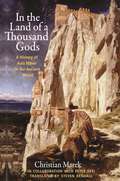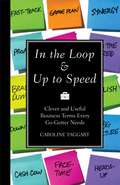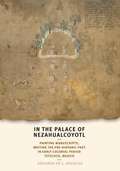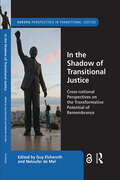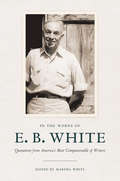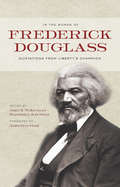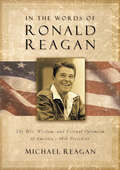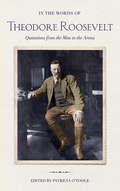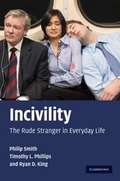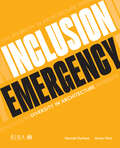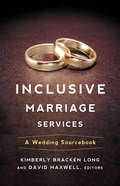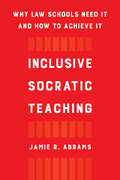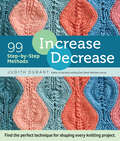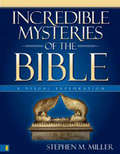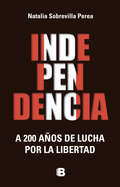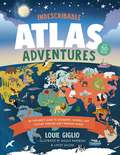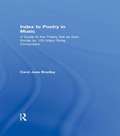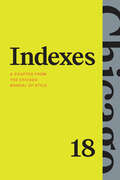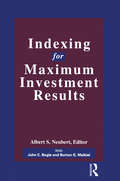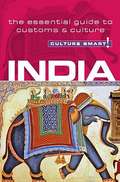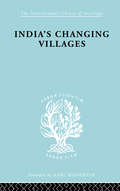- Table View
- List View
In the Land of a Thousand Gods: A History of Asia Minor in the Ancient World
by Christian MarekA monumental history of Asia Minor from the Stone Age to the Roman EmpireIn this critically acclaimed book, Christian Marek masterfully provides the first comprehensive history of Asia Minor from prehistory to the Roman imperial period. Blending rich narrative with in-depth analyses, In the Land of a Thousand Gods shows Asia Minor’s shifting orientation between East and West and its role as both a melting pot of nations and a bridge for cultural transmission. Marek employs ancient sources to illuminate civic institutions, urban and rural society, agriculture, trade and money, the influential Greek writers of the Second Sophistic, the notoriously bloody exhibitions of the gladiatorial arena, and more. He draws on the latest research—in fields ranging from demography and economics to architecture and religion—to describe how Asia Minor became a center of culture and wealth in the Roman Empire. A breathtaking work of scholarship, In the Land of a Thousand Gods will become the standard reference book on the subject in English.
In the Loop & Up to Speed
by Caroline TaggartThe bottom line is this: The workplace is a minefield of business jargon that people exchange on a daily basis, and it can all start to sound like everyone around you is speaking another language. So if you have ever wondered whether you have hit the glass ceiling or if a cubicle monkey will respond to mushroom management, become bogged down in the marzipan layer or are confused about what to do about the elephant in the room, this is the book for you. From indecipherable abbreviations and business terminology to buzzwords, motivational phrases, and more, In the Loop and Up to Speed uncovers the origins and meanings of many useful--and some not so useful--phrases that can be heard in the workplace and in everyday life, such as: · level playing field touching base· reinventing the wheel firing on all cylinders· brainstorming corporate DNA· methodology keeping your options open· raising the bar blue-sky thinking </d
In the Palace of Nezahualcoyotl
by Eduardo De J. DouglasAround 1542, descendants of the Aztec rulers of Mexico created accounts of the pre-Hispanic history of the city of Tetzcoco, Mexico, one of the imperial capitals of the Aztec Empire. Painted in iconic script ("picture writing"), the Codex Xolotl, the Quinatzin Map, and the Tlohtzin Map appear to retain and emphasize both pre-Hispanic content and also pre-Hispanic form, despite being produced almost a generation after the Aztecs surrendered to Hernán Cortés in 1521. Yet, as this pioneering study makes plain, the reality is far more complex. Eduardo de J. Douglas offers a detailed critical analysis and historical contextualization of the manuscripts to argue that colonial economic, political, and social concerns affected both the content of the three Tetzcocan pictorial histories and their archaizing pictorial form. As documents composed by indigenous people to assert their standing as legitimate heirs of the Aztec rulers as well as loyal subjects of the Spanish Crown and good Catholics, the Tetzcocan manuscripts qualify as subtle yet shrewd negotiations between indigenous and Spanish systems of signification and between indigenous and Spanish concepts of real property and political rights. By reading the Tetzcocan manuscripts as calculated responses to the changes and challenges posed by Spanish colonization and Christian evangelization, Douglas's study significantly contributes to and expands upon the scholarship on central Mexican manuscript painting and recent critical investigations of art and political ideology in colonial Latin America.
In the Shadow of Transitional Justice: Cross-national Perspectives on the Transformative Potential of Remembrance (Europa Perspectives in Transitional Justice)
by Guy ElcherothThis volume bridges two different research fields and the current debates within them. On the one hand, the transitional justice literature has been shaken by powerful calls to make the doctrine and practice of justice more transformative. On the other hand, collective memory studies now tend to look more closely at meaningful silences to make sense of what nations leave out when they remember their pasts. The book extends the scope of this heuristic approach to the different mechanisms that come under the umbrella of transitional justice, including legal prosecution, truth-seeking and reparations, alongside memorialisation. The 15 chapters included in the volume, written by expert scholars from diverse disciplinary and societal backgrounds, explore a range of practices intended to deal with the past, and how making the invisible visible again can make transitional justice - or indeed, any societal engagement with the past - more transformative. Seeking to combine contextual depth and comparative width, the book features two key case analyses - South Africa and Sri Lanka - alongside discussions of multiple cases, including such emblematic sites as Rwanda and Argentina, but also sites better known for resisting than for embracing international norms of transitional justice, such as Turkey or Côte d’Ivoire. The different contributions, grouped in themed sections, progressively explore the issues, actors and resources that are typically forgotten when societies celebrate their pasts rather than mourning their losses and, in doing so, open new possibilities to build more inclusive processes for addressing the present consequences of past injustice.
In the Words of E. B. White: Quotations from America's Most Companionable of Writers
by E. B. White"The time not to become a father is eighteen years before a world war."—E. B. White on fatherhood"I was lucky to be born abnormal. It ran in the family."—on luck"I would really rather feel bad in Maine than feel good anywhere else." —on Maine"The English language is always sticking a foot out to trip a man."—on language The author of Charlotte's Web and One Man's Meat, coauthor of The Elements of Style, and columnist for The New Yorker for almost half a century, E. B. White (1899–1985) is an American literary icon. Over the course of his career, White inspired generations of writers and readers with his essays (both serious and humorous), children's literature, and stylistic guidance. In the Words of E. B. White offers readers a delightful selection of quotations, selected and annotated by his granddaughter and literary executor, Martha White. The quotations cover a wide range of subjects and situations, from Automobiles, Babies, Bees, City Life, and College to Spiders, Taxes, Weather, Work, and Worry. E. B. White comments on writing for children, how to tell a major poet from a minor one, and what to do when one becomes hopelessly mired in a sentence. White was apt to address the subject of security by speaking first about a Ferris wheel at the local county fair, or the subject of democracy from the perspective of roofing his barn and looking out across the bay—he had a gift for bringing the abstract firmly into the realm of the everyday. Included here are gems from White's books and essay collections, as well as bits from both published and unpublished letters and journals. This is a book for readers and writers, for those who know E. B. White from his "Notes and Comment" column in The New Yorker, have turned to The Elements of Style for help in crafting a polished sentence, or have loved a spider's assessment of Wilbur as "Some Pig." This distillation of the wit, style, and humanity of one of America's most distinguished essayists of the twentieth century will be a welcome addition to any reader's bookshelf.
In the Words of Frederick Douglass: Quotations from Liberty's Champion
by Frederick Douglass"No people are more talked about and no people seem more imperfectly understood. Those who see us every day seem not to know us."—Frederick Douglass on African Americans"There is no negro problem. The problem is whether the American people have loyalty enough, honor enough, patriotism enough, to live up to their own constitution."—on civil rights"Woman should have justice as well as praise, and if she is to dispense with either, she can better afford to part with the latter than the former."—on women"The thing worse than rebellion is the thing that causes rebellion."—on rebellion"A man is never lost while he still earnestly thinks himself worth saving; and as with a man, so with a nation."—on perseverance"I am ever pleased to see a man rise from among the people. Every such man is prophetic of the good time coming."—on Lincoln Frederick Douglass, a runaway Maryland slave, was witness to and participant in some of the most important events in the history of the American Republic between the years of 1818 and 1895. Beginning his long public career in 1841 as an agent of the Massachusetts Anti-Slavery Society, Douglass subsequently edited four newspapers and championed many reform movements. An advocate of morality, economic accumulation, self-help, and equality, Douglass supported racial pride, constant agitation against racial discrimination, vocational education for blacks, and nonviolent passive resistance. He was the only man who played a prominent role at the 1848 meeting in Seneca Falls that formally launched the women's rights movement. He was a temperance advocate and opposed capital punishment, lynching, debt peonage, and the convict lease system. A staunch defender of the Liberty and Republican parties, Douglass held several political appointments, frequently corresponded with leading politicians, and advised Presidents Lincoln, Grant, Hayes, Garfield, and Harrison. He met with John Brown before his abortive raid on Harpers Ferry, helped to recruit African American troops during the Civil War, attended most national black conventions held between 1840 and 1895, and served as U.S. ambassador to Haiti. Frederick Douglass has left one of the most extensive bodies of significant and quotable public statements of any figure in American history. In the Words of Frederick Douglass is a rich trove of quotations from Douglass. The editors have compiled nearly seven hundred quotations by Douglass that demonstrate the breadth and strength of his intellect as well as the eloquence with which he expressed his political and ethical principles.
In the Words of Ronald Reagan: The Wit, Wisdom, and Eternal Optimism of America's 40th President
by Michael ReaganThis collection of Reagan’s words and writings—both public and private—offers an intimate portrait of the president, actor, icon, and family man.As one of America’s greatest presidents, Ronald Wilson Reagan succeeded in renewing pride in our country, and strengthening the principles of family, faith, and freedom on which it was founded. President Reagan endeared himself even to his political opponents with his self-effacing wit and irrepressible optimism. Inspiring, thoughtful, and at times downright funny, he had a gift for stirring emotion, sparking debate, and calling a nation to action.Ronald Reagan’s oldest son Michael has gathered a wonderful collection of his father’s public and private words, from hilarious one-liners to eloquent letters to intimate family moments. Complemented by Michael Reagan’s personal and insightful commentary on his father’s life, In The Words of Ronald Reagan will delight you, inspire you, and motivate you to finish the job Reagan began—the job of rebuilding the American dream.
In the Words of Theodore Roosevelt: Quotations from the Man in the Arena
by Theodore Roosevelt Patricia O'TooleThe public life of Theodore Roosevelt (1858-1919) was marked by his service as the twenty-sixth President of the United States, Vice President, Governor of New York State, Assistant Secretary of the Navy, U.S. Civil Service Commissioner, President of the New York City Police Commission, and New York State Assemblyman. In his life outside of government he was famous as an author, naturalist, rancher, big game hunter, and explorer. The twentieth century would become known as the American Century, and it was Theodore Roosevelt, through his foreign policy, who ushered the United States into the ranks of the world's great powers. In domestic affairs, he used his presidential powers to level the playing field between capital and labor, to protect consumers, and to establish a conservation program that was far-sighted and comprehensive, covering the nation's natural resources, its wilderness areas, its endangered species, its scenic beauty, and the cultural artifacts of its indigenous peoples.Distilled from Roosevelt's voluminous writings and speeches, In the Words of Theodore Roosevelt is a discerning collection of quotations by this American icon who continues to inspire and captivate an extraordinary array of twenty-first-century Americans. Carefully selected and organized by topic by Patricia O'Toole, these quotations reflect the vast range of Roosevelt's interests, the depth of his wisdom, his almost superhuman energy, and his directness. Many of the issues that Roosevelt addressed-from America's international role to the environment-remain pressing concerns today, giving his century-old words remarkable currency. This singular collection of quotations-enhanced by O'Toole's illuminating introductory essay, notes on biographical and historical context, and bibliographies of Roosevelt's writings-is a trove for writers, teachers, students, and all who recognize Theodore Roosevelt's unique role in U.S. history.
Incidental Tourist
by Peter DohertyJoin Nobel Prize winner Peter Doherty on his extraordinary adventures around the globe. Doherty's dazzling schedule can leave his head spinning. So what happens when he lifts his gaze and asks: 'What the hell am I doing here?' Doherty has kept a journal about the far-flung destinations his work has taken him to for more than thirty years. His observations and discoveries in The Incidental Tourist make for perfect armchair travel.
Incivility
by Philip Smith Timothy L. Phillips Ryan D. KingHas anyone ever pushed in front of you in a queue? Stolen your parking space? Talked on their mobile phone during a film at the cinema? In our everyday lives we all encounter rude and inconsiderate people. This unique book provides the first ever systematic investigation of typical encounters with rudeness. Through a meticulous analysis of over 500 events it maps out what people experience as rude, where and when this happens, and what takes place in the exchange between the participants. The inquiry further charts the emotional and social consequences of rudeness and victimization, with the results challenging the widespread assumption that bad behaviour is toxic to community life. In conclusion the study draws upon its findings and surveys a range of strategies for reducing the level of incivility in everyday life, identifying some simple and innovative solutions. Incivility will appeal to criminologists, sociologists and scholars of urban studies.
Inclusion Emergency: Diversity in architecture
by Hannah Durham Grace ChoiArchitecture is at a tipping point. Voices of the under-represented have been increasing in volume and are agitated for change. If we don’t collectively listen, re-adjust and change our future outlook, we limit the potential relevance of the profession in today’s society and, ultimately, the places we create. Capturing insight from leading voices in the profession, this book encourages understanding, reflection and addresses critical questions, providing steps towards meaningful change. It will help those who are under-represented to find role models, context and tools & to be confident, supported and valued. Building understanding for those more privileged to acknowledge bias, it will enable mitigation and awareness of the issues to encourage meaningful action. This is a call for change. Now.
Inclusive Education For The Print Disabled Children - WBM (World Bank Modules)
by BookshareThe module on inclusive education for print-disabled children emphasizes the importance of integrating children with special needs into mainstream classrooms from an early age. It aims to equip teachers with the knowledge and confidence to identify signs of disabilities among children, make necessary curriculum modifications, and provide accessible teaching materials. Addressing challenges such as lack of awareness, identification difficulties, and infrastructure gaps, the module stresses the need for early identification and intervention, while also outlining steps for successful inclusion. It underscores the significance of adapting teaching methods, involving parents and peers, and seeking specialist assistance to create an inclusive environment where children with disabilities are encouraged to participate fully in academics and extracurricular activities, fostering a sense of belonging and enhancing their overall development. Furthermore, it highlights specific challenges faced by visually impaired students and provides comprehensive checklists for classroom adaptations, safety considerations, and collaboration with specialists, offering a holistic guide for educators working towards inclusive education for children with disabilities.
Inclusive Games, Recreation and Technology for Daily Living - WBM (World Bank Modules)
by BookshareThis comprehensive resource focuses on empowering visually impaired children through inclusive games, recreational activities, and technological aids for daily living. It delves into the pivotal role of games in the early developmental stages of visually impaired children, offering insights into crafting simple games using everyday objects. Furthermore, it explores various tactile books, treasure baskets, and sensory development resource boxes designed to engage and stimulate the child's senses and curiosity. The resource also highlights examples of audio games, online resources, and assistive technologies tailored to augment the child's learning, employment prospects, and recreational opportunities. Additionally, it discusses strategies to involve visually impaired children in extracurricular pursuits such as sports, music, dance, and collaborative projects within school and community settings, fostering their holistic growth and participation in diverse activities.
Inclusive Marriage Services
by Kimberly Bracken Long David MaxwellAs the country moves toward marriage equality for gays and lesbians, couples and pastors are in need of updated language for marriage services. This sourcebook not only provides inclusive marriage services, taking into account a variety of situations, but also provides guidance for couples and pastors to take into account for all couples. In addition, it includes prayers for a number of situations that happen around many weddings, such as rehearsal dinners, the wedding participants before worship, and the reception. Inclusive Marriage Services includes updated but traditional language carefully chosen, resembling historical marriages we are all familiar with, but improving some of the language.
Inclusive Socratic Teaching: Why Law Schools Need It and How to Achieve It
by Jamie R. AbramsFor more than fifty years, scholars have documented and critiqued the marginalizing effects of the Socratic teaching techniques that dominate law school classrooms. In spite of this, law school budgets, staffing models, and course requirements still center Socratic classrooms as the curricular core of legal education. In this clear-eyed book, law professor Jamie R. Abrams catalogs both the harms of the Socratic method and the deteriorating well-being of modern law students and lawyers, concluding that there is nothing to lose and so much to gain by reimagining Socratic teaching. Recognizing that these traditional classrooms are still necessary sites to fortify and catalyze other innovations and values in legal education, Inclusive Socratic Teaching provides concrete tips and strategies to dismantle the autocratic power and inequality that so often characterize these classrooms. A galvanizing call to action, this hands-on guide equips educators and administrators with an inclusive teaching model that reframes the Socratic classroom around teaching techniques that are student centered, skills centered, client centered, and community centered.
Inclusive and Accessible Examinations and Evaluations - WBM (World Bank Modules)
by BookshareThis module on Inclusive and Accessible Examinations and Evaluations for students with diverse needs offers a comprehensive guide for educators at primary and secondary levels. Emphasizing fair evaluation methods, it introduces alternate assessment approaches like assignments, group projects, periodic tests, and examinations, while focusing on modifications necessary for children with special needs. The module outlines essential considerations for framing test questions and conducting practical evaluations, providing extensive examples requiring modifications across various grades and subjects. Additionally, it offers a detailed roadmap, aligning with the Central Board of Secondary Education's recommendations, ensuring fair opportunities and assistance, such as the use of scribes, additional time, special provisions for visual impairment, and adaptations in examination formats. The advisory to schools stresses inclusive education, enrollment monitoring, provision of assistive devices, teacher training, and creating a disability-friendly environment, reaffirming the commitment to comprehensive inclusion practices in educational institutions.
Increase, Decrease: 99 Step-by-Step Methods; Find the Perfect Technique for Shaping Every Knitting Project
by Judith DurantThe secret to knitting great-fitting hats and shaping elegant sleeves lies in using the right increase or decrease techniques. Approachable and insightful, Judith Durant provides clear instructions and step-by-step photographs that showcase swatches for each technique. From working shaped lace to adjusting necklines, you’ll soon have a go-to strategy for successfully tackling knitting challenges of all shapes and sizes.
Incredible Mysteries of the Bible: A Visual Exploration
by Stephen M. MillerWhere was the garden of Eden? What happened to the ark of the covenant? What is the unforgivable sin Jesus spoke of? If you’ve ever wondered about these or other questions while reading the Bible, then this is the book for you. Here is a fascinating look at some of the most perplexing mysteries found in the pages of the Bible. Drawing from the latest research in both archaeology and biblical studies, Incredible Mysteries of the Bible sheds fascinating and helpful light on fifty topics. Each article is accompanied by beautiful full-color images and helpful sidebars. Whether you read the book cover to cover or dip in and out at your leisure, you’ll gain a greater understanding of the world and message of the Bible. So grab your sleuthing hat and dig in!
Independencia: A 200 años de lucha por la libertad
by Natalia Sobrevilla PereaEn Independencia, la historiadora Natalia Sobrevilla nos invita a pensarnos como país desde el relato de la gesta emancipadora. La publicación da cuenta de los antecedentes que marcaron el fin del periodo colonial, eventos, personajes y escenarios protagónicos de la independencia del Perú. Cuando se piensa en la Independencia del Perú, se suele poner el foco en la proclamación del general San Martín en Lima, el 28 de julio de 1821. Sin embargo, la complejidad de ese acontecimiento amerita una reflexión que permita comprenderlo más allá del límite celebratorio de las fechas patrias. En Independencia, la historiadora Natalia Sobrevilla nos invita a pensarnos como país desde el relato de la gesta emancipadora, entendida como un hecho de dimensiones tanto nacionales como globales, donde confluyen diversos factores cuyas repercusiones alcanzan nuestro presente. El libro da cuenta de los antecedentes que marcaron el comienzo del fin del periodo colonial, los planes iniciales independentistas, la Expedición Libertadora de Lima, los primeros gobiernos, las maniobras a los puertos llamados intermedios, hasta el desenlace de la batalla final. Además de considerar los eventos, figuras y escenarios protagónicos de la Independencia, la autora ha sabido darles visibilidad a las personas comunes y corrientes, cuyas vidas cambiaron radicalmente al enfrentar las vicisitudes de la guerra. Estas páginas recrean una memoria común y permiten revisar los orígenes de la República en la que vivimos y lo que representa formar parte de ella. Son también un motivo para calibrar, en su justa dimensión, el sentido y el valor del Bicentenario.
Indescribable Atlas Adventures: An Explorer's Guide to Geography, Animals, and Cultures Through God's Amazing World (Indescribable Kids)
by Louie GiglioWith more than 50 infographic maps, this illustrated world atlas for kids from bestselling author Louie Giglio will stretch your children's understanding of the world as they discover more about God, science, and His amazing world!Indescribable Atlas Adventures offers a self-guided tour for your favorite explorer throughout the seven continents and over 50 countries. Easy-to-read maps, more than 1,500 facts, and a world map that helps kids identify each continent and country will help your child to think globally and discover new insights into God's incredible creation. Each map includesan overview of each country's population, languages, and prominent features;key facts about the country's capital cities; neighboring countries; and the national bird, tree, and dish;notable people and their amazing achievements;the country's terrain, climate, wildlife, contributions to space exploration, cultural hallmarks, and Christian faith traditions; andbiblical and inspirational pieces, like devotional thoughts, prayers, and Bible verses that highlight how amazing God and His world are.Indescribable Atlas Adventures is for ages 6 to 10 and spotlights several fascinating ecosystems, like the Sahara, Amazon, and Great Barrier Reef. This book has a large trim size to help kids explore fun details on each page and is a perfect "my first atlas of the world" gift for curious kids.Check out these other books from Pastor Louie's Indescribable Kids series, which has sold more than a million copies:IndescribableHow Great Is Our GodThe Wonder of CreationIndescribable for Little OnesIndescribable Activity Book for Kids
Index to Poetry in Music
by Carol June BradleyFirst Published in 2003. Routledge is an imprint of Taylor & Francis, an informa company.
Indexes: A Chapter from "The Chicago Manual of Style," Eighteenth Edition
by The University of Chicago Press Editorial StaffIndexing A–Z from The Chicago Manual of Style—the undisputed authority for style, usage, and grammar. In this age of searchable text, the need for an index made with human input is sometimes questioned. But a good index can do what a plain search cannot: It gathers all the substantive terms and subjects of the work, sorts them alphabetically, provides cross-references to and from related terms, and includes specific page numbers or other locators or, for electronic formats, direct links to the text. This painstaking intellectual labor serves readers of any longer work, whether it is searchable or not. For searchable texts, an index provides insurance against fruitless queries and unintended results. In a word, a good index makes the text more accessible. Most book indexes must be assembled swiftly between the time page proofs are issued and the time they are returned to the typesetter—usually about four weeks. An author preparing their own index will have to proofread as well as index the work in that short time span. This insightful chapter-length booklet will guide both professionals and first-time indexers in assembling an index that will do justice to both the book and the reader.
Indexing for Maximum Investment Results
by Albert S. NeubergTwenty four years after investment managers decided to implement Standard & Poor's 500 indexing strategy, the verdict is in. The first indexers beat more than 99% of all actively managed stock funds. Over the last ten years, funds based on the S&P 500 out-performed more than 80% of all mutual funds. Today about $450 billion is indexed to the S&P 500, almost 10% of the total market value of all stocks traded in the US. The strategy has been applied to other asset classes, including bonds and real estate. In total, indexing now accounts for more than 25% of the investment methodology of all pension funds in the US. Topics include: choosing a benchmark; overview of the marketplace; using derivatives to index; performance track record versus active management; index methodology and other styles; and index price effects on constituent securities. Albert S. Neubert is director of the Domestic S&P Indexes Unit within the Equity Services Group.
India - Culture Smart!
by Becky StephenIndia is in transition. Since the publication of Culture Smart's first guide to India in 2003, it has been transformed from a developing, third-world country into the world's fastest growing economy. Today, a huge, confident, emerging middle class is exporting technology, brains, and enterprise to the rest of the world. At the same time, young Indians educated abroad are returning home to take advantage of the new opportunities, bringing Western expectations and lifestyles with them. The impact of all this wealth-creation, modernity, and individualism on the timeless values and ancient caste structures of India is beginning to be felt well beyond the great cities, adding yet another facet to the giant kaleidoscope of Indian society. This completely new and up-to-date volume by American author Becky Stephens is unrivalled. It highlights the many subtle and not so subtle changes that are taking place in Indian society, describes and explains those areas of life where traditional attitudes and practices continue to prevail, and offers original insights, practical tips, and vital human information to guide you through the pitfalls and delights of this complex, vibrant, and increasingly important country.
India's Changing Villages (International Library of Sociology)
by S.C. DubePublished in 1998, India's Changing Villages is a valuable contribution to the field of Sociology & Social Policy.
